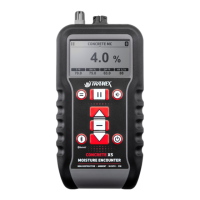CONCRETE MOISTURE ENCOUNTER X5 USER GUIDE
28
CALIBRATION CHECK SALTS
A saturated salt solution is the most suitable method
for on-site testing of humidity sensors. The advantage
of the on-site salt calibration check is that the user can
check that the sensors are performing satisfactorily
without having the need to send the sensors to a testing
laboratory, which can be expensive and time consuming.
The sensors can be checked at a time that is convenient
to the user, which means no down time for your
equipment. ASTM F2170 requires that humidity probes
are checked and readings recorded by the user within
30 days before use. This check can be achieved with a
75% RH saturated Sodium Chloride (NaCI) solution.
Conditioning of the NaCI calibration check solution and
test procedure.
As Relative Humidity (RH) is defined as the ratio of
the partial vapor pressure in air to the saturated vapor
pressure at a given temperature, it is important to
understand that RH strongly depends on temperature.
Therefore, it is essential to keep humidity sensors at
the same temperature as the air in which the relative
humidity is to be measured. When testing RH probes
in a calibration check-salt chamber, it is necessary for
the internal temperature of the salt chamber to be the
same as that of the surrounding air and also the RH
probe sensor. This can be achieved by removing the
cap and exposing the salt-check solution to ambient
conditions. The temperature can be checked with the
use of an infrared thermometer. When the probe and
solution are showing equal temperature insert the
probe into the solution.

